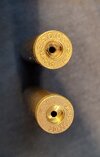The Army has played with variations on the flash hole, several times in the past, size, shape, off-center, burrs, etc, it really doesn't make any difference. Except Berdan primers, on average, they might be more consistent in terms of pressure and velocity. . .
EDIT:
Oh, and on a related, but tangential note, the Germans in WW2 found that Berdan primed ammunition worked just as well with only one of the two flash holes. Their machinery was set up to gang drill both flash holes in the same pass, and what happened was, due to poor materials for the drills, the drills had an increased tendency to break. This meant the line had to stop production while they replaced the drill. They did some testing and found that there was no statistical difference in performance. So, they started to replace drills only when both of them were broken.



